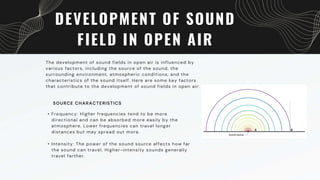
acoustic DEVELOPMENT AND THRESHOLD OF SOUND.pptx
- 1. DEVELOPMENT OF SOUND FIELD IN OPEN AIR The development of sound fields in open air is influenced by various factors, including the source of the sound, the surrounding environment, atmospheric conditions, and the characteristics of the sound itself. Here are some key factors that contribute to the development of sound fields in open air: • Frequency: Higher frequencies tend to be more directional and can be absorbed more easily by the atmosphere. Lower frequencies can travel longer distances but may spread out more. • Intensity: The power of the sound source affects how far the sound can travel. Higher-intensity sounds generally travel farther. SOURCE CHARACTERISTICS
- 2. • Temperature: Sound speed increases with temperature. Warmer air tends to allow sound waves to travel faster and more efficiently. • Humidity: Humid air can carry sound better than dry air, as water vapor molecules can transmit sound waves.. • The type of ground surface (e.g., grass, concrete, water) can impact sound reflection and absorption. • Wind can affect the propagation of sound waves. It may carry sound away from or toward the listener, depending on the wind direction. • The landscape, presence of buildings, trees, or other obstacles can reflect, absorb, or diffract sound waves, altering their path and intensity. ATMOSPHERIC CONDITIONS GROUND SURFACE: WIND SPEED AND DIRECTION: TERRAIN AND OBSTACLES:
- 3. • As sound travels away from its source, it spreads out, leading to a decrease in intensity known as sound attenuation. The inverse square law describes this phenomenon, where the intensity of sound decreases with the square of the distance from the source. • Sound propagation can be influenced by the time of day, as temperature, wind, and atmospheric conditions vary. • Sound waves can bounce off surfaces, causing reverberation. This can enhance or degrade the quality of sound depending on the environment. • Weather conditions such as temperature inversions or atmospheric ducting can lead to sound being trapped or carried over longer distances. DISTANCE FROM THE SOURCE: TIME OF DAY: REVERBERATION: METEOROLOGICAL CONDITIONS:
- 4. THRESHOLD OF SOUND The threshold of sound, often referred to as the auditory threshold, is the minimum intensity or loudness of a sound that can be detected by the human ear. It varies depending on the frequency of the sound wave. The measurement of sound intensity is typically expressed in decibels (dB) . The human ear is most sensitive to sounds in the frequency range of around 2,000 to 4,000 Hertz (Hz). The threshold of hearing for a standard reference frequency of 1,000 Hz is commonly defined as 0 decibels sound pressure level (dB SPL). This means that sounds with an intensity level below 0 dB SPL are generally not audible to the average human ear. The threshold of sound is not a fixed value but can vary among individuals. It's important to note that the threshold of sound is just the beginning of the range of sound levels that the human ear can perceive. As the intensity of a sound increases, it becomes more audible, and different levels of loudness can be distinguished. Here is a rough guide to give you an idea of the typical threshold of hearing for average human ears at different frequencies: • 0 dB SPL: Threshold of hearing at 1,000 Hz (reference frequency) . • 10-20 dB SPL: Very quiet sounds, like a whisper or rustling leaves. • 30-40 dB SPL: Quiet ambient noise in a quiet room. • 60 dB SPL: Normal conversation. • 90 dB SPL: Traffic noise . • 120 dB SPL: Rock concert or loud music.
- 5. MEASUREMENT OF SOUND LEVEL Sound level is typically measured in decibels (dB), a logarithmic unit that expresses the ratio of a particular sound pressure to a reference sound pressure. The formula for calculating sound level in decibels is: This formula reflects the fact that the human ear perceives sound intensity on a logarithmic scale. Each increase of 10 dB represents a tenfold increase in sound intensity. Sound level measurements can be made using a sound level meter, a device specifically designed for this purpose. Sound level meters measure the pressure variations in the air caused by sound waves and provide a readout in decibels. • L is the sound level in decibels. • p is the sound pressure being measured. • p0 is the reference sound pressure, typically set to 20×10−620×10−6 pascals (Pa) for air.
- 6. There are various weighting scales used in sound level measurements to account for the sensitivity of the human ear at different frequencies. The two most common types are A-weighting (dBA) and C-weighting (dBC). A- weighting is often used for general environmental noise measurements, while C-weighting is used when assessing noise in industrial settings or situations where low-frequency sounds are significant. It's important to note that decibel values are relative and should be referenced to a specific standard or context. For example, sound levels may be reported as dB SPL (Sound Pressure Level) when measured in reference to a standard sound pressure of 20×10−620×10−6 Pa. Additionally, peak sound levels and equivalent continuous sound levels (Leq) are commonly used in different applications to provide a comprehensive view of the sound environment over time.